How To Repair Water Damaged Plaster Wall
How to Repair Water Damaged Plaster
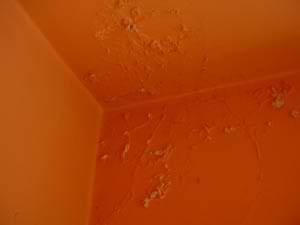
When iii-coat plaster gets wet, even slightly, the surface will normally show some visual signs. A brown stain may appear in ceilings or walls. With a heavy soaking, the surface may begin to bubble from the chemical reaction of the lime. As the surface dries, it may harden and the surrounding paint volition begin to flake off. Water harm effects may be minor, isolated to the surface layer of the wall, or it may penetrate the whole three-coat structure, causing crumbling brown and scratch coats that fall off the lath. In some cases, the lath may also be damaged, showing rotted woods or rusted metal nether the plaster coats.
Plaster that has gotten wet is best repaired using setting-blazon joint compound, likewise chosen mud. Ready-mixed chemical compound volition not be hard plenty and is vulnerable to any residuum wet in the wall fabric. The repair process on this page can be used to repair water damage to the surface layers of plaster walls and ceilings. Check here for a video demonstrating how to repair water-damaged plaster If y'all have more severe plaster damage with wall cloth falling off the board, use the process at this link to make repairs.
Remove the Damaged Plaster
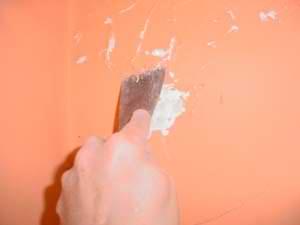
Before outset repairs to walls or ceilings that have been damaged past water, locate and end the source of the leak or you will be repairing the aforementioned impairment again very soon. Also, be sure the plaster has time to dry out completely before attempting to showtime repairs.
The first stride to making repairs is to remove all the damaged material. This includes: all the bubbling and peeling paint, crumbling plaster coats, and any degraded board. Use a putty knife to lift off flaking pigment and bubbles plaster. Apply firm pressure with the blade to dig out all the soft, loose material.
Go around the edges of the damaged area, digging with the knife until you reach difficult, undamaged plaster. Test the paint coat immediately surrounding the area to see if it will pare off easily. Work out from the center of the damage with a putty knife to remove any loose paint.
Seal the Water Harm
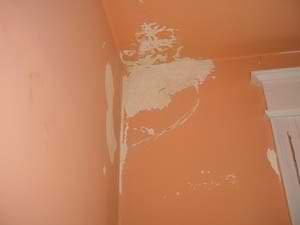
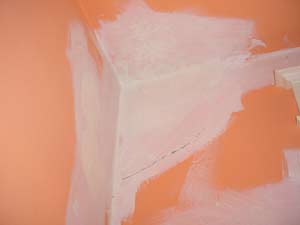
Go over the surface with a stiff nylon castor and shop-vac to remove any loose particles. Wash the surrounding surfaces using a sponge and bucket of clean water to remove any residual lime deposits and allow the wall dry out completely before proceeding.
With the surface clean and dry out, coat the surface area with oil-based or quick-dry primer-sealer. Priming is essential to block any residual contamination that may remain in the surface and inhibit the bail with the patching compound. It will as well prevent stains from bleeding through the finish paint which could issue in bubbling of the new paint coat.
Stir the primer or milk shake the can vigorously to be certain it's completely mixed. Coat all afflicted surfaces and overlap onto the surrounding wall paint. Let the primer dry completely before applying whatever repair compound. Quick-dry primers volition dry in about an hour, oil paint may take as long as 24 hours to dry completely.
Repair the Plaster
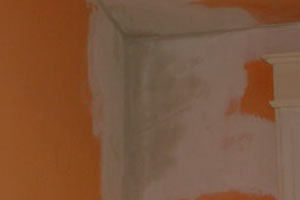
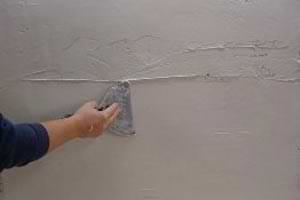
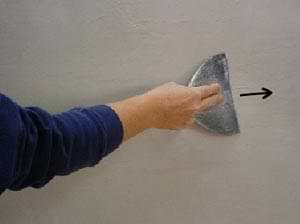
Repair shallow surface damage using several sparse coats of articulation chemical compound to fill in the missing plaster and level out the wall. Mix a pocket-size amount of compound and use a flexible joint knife to apply a starting time coat. "Butter" the area with near a ¼ inch coat of mud and then immediately go dorsum over information technology to skim off the excess using parallel strokes from one side of the repair to the other.
Float the bract across the deeper damage to make full it in and skim harder on the surrounding walls to leave a very thin coat in that location. As you piece of work, don't let mud build upwardly higher over the repair surface area than it is on the surrounding surfaces to go along things level. Also, avert leaving thick mud around the perimeter to avoid unnecessary sanding when yous're done.
If you have a large area to repair, utilize a long, sparse lath like a piece of lattice molding to go over the whole expanse at once. Rest the board on the surrounding surface and drag it across the wet mud a couple times to smooth out the loftier points in the overall repair. Ignore any ridges or other inconsistencies in the mud surface. Subsequently information technology sets you tin can scrape these off before applying another coat of mud.
Let the joint compound set until it hardens and then utilize the joint knife with an upward stroke to shave off any ridges or other roughness in the surface. Use course to medium sandpaper to remove any other bumps, etc. if necessary. A completely smooth surface is not required here, just remove any high points. Castor off the dust and wipe the area with a clean, damp rag or sponge to remove the scraping and sanding dust earlier coating it once again with mud.
Utilize a Second Coat of Articulation Compound
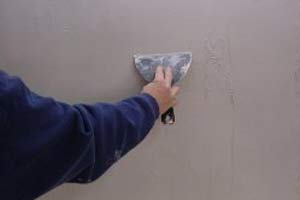
Employ a second thick coat of mud buttering the surface as earlier. Concentrate on filling in the deepest parts of the damage and keeping a lighter coat around the edges.
Immediately skim off the backlog mud using parallel strokes again only this fourth dimension go in a perpendicular management to the first coat. If you lot used horizontal strokes the kickoff fourth dimension, use vertical strokes this fourth dimension. Ignore whatever ridges left by the knife blade but keep the mud as sparse as possible on the surrounding wall surface to minimize sanding when you're done.
When the second coat has gear up, scrape, sand, and wipe off the dust as before. Use as many additional coat as needed to fill in all the damaged plaster. Every bit you lot work, remember to avert a build upwards of mud on the surrounding surfaces and reverse direction with each new coat to keep the repair level.
Sand and Touch Up Pigment
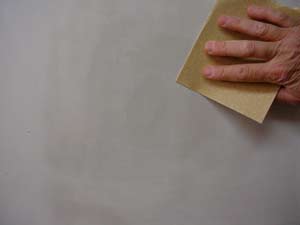
Allow the last coat of joint chemical compound fix and dry out completely and then sand the whole patch with 120 sandpaper. Be sure to smooth the outer edges of the patch into the surrounding wall surface. Wipe off the sanding grit with a damp rag and prime number the new repair and surrounding surfaces with the same primer-sealer used before.
Using a solvent-based primer-sealer instead of latex paint is essential hither to prevent whatsoever residual h2o contagion from inhibiting the bail with the new paint coat. Latex is fine for a end coater over the primer but it may chimera if applied direct over previous water damage. Permit the primer dry out completely earlier touching up or applying the stop wall pigment.
- How to Repair Bubbling Pigment
- How to Repair Torn Drywall Paper
- Repairing Water Damaged Drywall
- Repairing Water Damaged Plaster
- Repairing Crumbling Plaster
- Repairing Major Plaster Harm
- Repairing Forest Lath Plaster
- Repairing Drywall Nail Pops
- Repairing Small Wall Holes
- Repairing Large Wall Holes
- Repairing Large Ceiling Holes
- Repairing Small-scale Ceiling Holes
- Repairing Wall and Ceiling Cracks
- Repairing Cracks with Expanding Foam
- Installing a Drywall Ceiling
- Finishing Recessed Drywall Joints
- Finishing Metal Drywall Corner Dewdrop
- Finishing Newspaper Corner Bead
- Finishing Within Drywall Corners
- Finishing Drywall Butt Joints
- How to Exercise Drywall Texturing
- Skim Blanket on Walls and Ceilings
- Sanding Drywall Joint Chemical compound
- Wall Tools and Materials Guide
Source: https://www.do-it-yourself-help.com/how-to-repair-plaster-water-damage.html
Posted by: lattimoredected.blogspot.com


0 Response to "How To Repair Water Damaged Plaster Wall"
Post a Comment